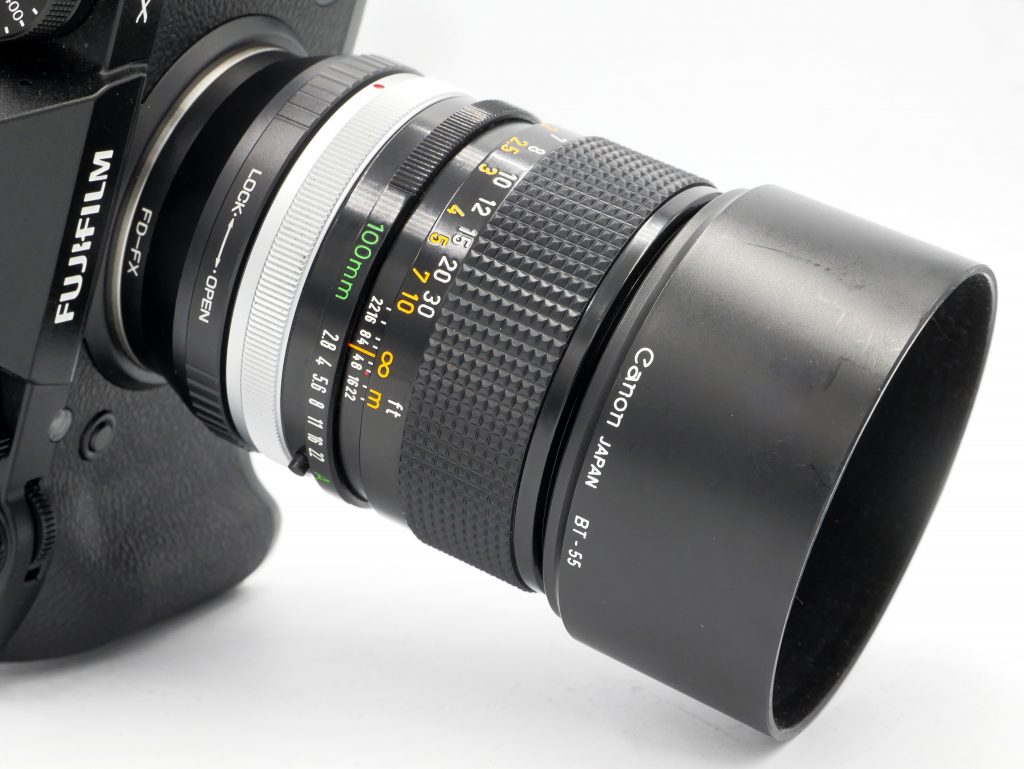
Post by Paul Brodek our Used Equipment buyer
Today’s featurette is another lens profile highlighting a specific vintage lens, and category, that delivers great images on film, and could also still be a valuable arrow in your (mirrorless) digital quiver. The specific lens is a 1977 Canon FD 100mm f/2.8 S.S.C. breech-mount lens. More on that alphabet soup shortly.

We all kinda know that a 50mm lens is considered “normal” on a full-frame 35mm negative or digital sensor. “Normal” meaning it renders subjects about the same size as they appear to our eyes/brains, but without the very wide peripheral vision our eyes/brains see. Focal lengths shorter than 50mm are wide-angle, longer are telephoto. Very simply, wide lenses make everything look smaller and tele lenses make everything look bigger. Most of us think of 135mm+ when we think of telephoto, overlooking the 85-90-100-105mm range of short-tele lenses. What we’re overlooking in the short-tele range are excellent portrait and macro lenses.

I’m going to skip over macro lenses right now, since the FD 100/2.8 ain’t macro. We’ll do macro when a good one crosses my desk. On the portrait side, an 85-105mm is considered ideal because it renders human subjects in a slightly flattened perspective, which pleases our eyes/brains, while also making it easier to soften distracting backgrounds, leaving the visual emphasis on the subject. I don’t have a lot of space here for optical lessons and brain science, not that I actually understand much of that, so forgive the following compressed explanation.
Our eyes deliver light/data to our retinas, and our brains sort that out into a 3-dimensional moving image that we experience as “reality.” Those quotes have meaning, but there’s even less space for zen here than brain science.
Photography involves rendering that same light/data into only 2 dimensions, and that’s where lens choice and perspective matter. Wide-angle lenses make everything smaller, so shooting a head-and-shoulders portrait with a wide lens means basically shoving the lens in the subject’s face. With the front of the lens inches away from the subject’s kisser, the nose is much closer to the film/sensor than the ears. Squash that image into 2 dimensions, and your brain sees something like that stereotypical shot of a camel’s head from a fisheye lens: the nose looms huge, the ears and rearward chunks of head are tiny and fade away. Not the best way to show how lovely somebody looks.
Longer lenses put the camera further from the subject, with noses/ears/etc relatively the same distance from the film/sensor, so squashed into 2D you get the kind of face your brain usually shows you—-your subject looks swell, instead of something from a nightmare. The longer lens also narrows the amount of background shown, which isolates the subject better. You also have narrower/less depth of field, so it’s easier to throw the background out of focus, which also puts more visual emphasis on your subject.
As for history, we need to talk about lens mounting. The earliest/easiest method was screwmount, which gave a solid mount, but took a lot of time/effort, could be cross-threaded if you’re clumsy, and made extensive lens/body connections, and exposure automation, difficult. Bayonet mount followed, which involved aligning body/lens index marks and twisting the lens home. Faster, easier, harder to mess up, but subject to wear, leading to play between the body/lens, which can result in focusing inaccuracy and misalignment of critical lens/body components.
Canon was trying to challenge Nikon’s lead with their F-series SLRs, and came up with the Breech Lock mechanism. You line up the index marks, and instead of turning the entire lens, you turn a rotating ring at the base of the lens. The lens/body indexing pins and such don’t move, so they stay properly aligned, and any lensmount wear get compensated for by just tightening the mounting ring more. But the mechanism overall was more complex, and lotsa folks managed to screw it up. Canon ditched the external ring, designing an internal breech mechanism, so you rotated the entire lens like a bayonet mount. This caused fewer problems, but was still more problematic than a standard bayonet. When Canon went autofocus, they went to a standard bayonet mount.
The S.S.C. designation on the lens beauty ring is Canon’s designation for their new, advanced Super Spectra Coating multicoating. Super-dee-duper! Improvements in lens design and multicoating techniques throughout the ’70s were yielding improvements in image quality, the coatings specifically minimizing flare and enhancing contrast and color saturation. Canon introduced S.S.C. coating on higher-end lenses, and they wanted to make sure you knew what you were paying for.
Moving into our modern digital world, we’ve already talked about adapting vintage lenses to mirrorless digital bodies with inexpensive adapters. Vintage film-era wide-angle lenses tend to scatter light out from the rear element, which can cause issues with digital sensors. You’ll often see softness and weird color shifts in the corners, which Photoshop can’t always fix. Normal/tele lenses have a straighter light path, causing fewer problems on digital sensors. These vintage 85-105mm lenses can make some really nice images on modern sensors, with minimum postprocessing corrections.

You’ll see two images of Paul F., aka Skweegee, one of our forever regulars, one shot on an APS-C Fuji XT3, the other on a Micro-4/3 Panasonic Lumix G9. Both shot wide-open, minimum post, both pretty durn sharp. The smaller 4/3 sensor looks a little sharper, that’s most likely the deeper depth of field on the smaller sensor. Both still have a nice soft background, showing Skweegee and his various hair/jewelry in all its glory.
The featured Canon FD 100/3.5 lens is very clean, with spectacularly clear glass, includes front/rear caps and the all-important lens hood, is rated Exc+ and is priced at $129.99. Oh and BTW, the super-secret code stamped on the back of the lens is Canon’s production code. The internet will help you figure out this lens was build in June of ’77.